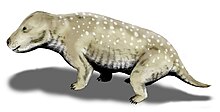Traversodontid
| Traversodonts Temporal range: Middle Triassic - Early Jurassic |
|
|---|---|
 |
|
| Exaeretodon frenguellii | |
| Scientific classification | |
| Kingdom: | Animalia |
| Phylum: | Chordata |
| Order: | Therapsida |
| Suborder: | Cynodontia |
| Stem group: | †Gomphodontia |
| Family: |
†Traversodontidae von Huene, 1936 |
| Subgroups | |
Traversodontidae is a family of herbivorous cynodonts. Traversodonts were primarily Gondwanan, with many species known from Africa and South America. Recently, traversodonts have also been found from Europe and eastern North America. Traversodonts first appeared in the Middle Triassic, diversified in the Late Triassic, and became extinct in the Early Jurassic. The family Traversodontidae was created by Friedrich von Huene in 1936 for cynodonts first found in São Pedro do Sul in Paleorrota, Brazil.
Traversodonts are members of Gomphodontia, a group of herbivorous cynognathian cynodonts. As an adaptation toward eating plants, they have wide postcanine teeth behind large canines. These postcanines are closely spaced with their crowns touching each other. Each is usually wider than it is long and is covered in several cusps. Because of their complexity, postcanine teeth are the primary means of identifying and distinguishing different species of traversodonts.
Traversodonts have relatively short skulls. The snout is much narrower than the back of the skull. The tip of the snout is wider than the middle, as it constricts behind the large canines. The tooth rows of the upper jaws are inset while the maxillae and zygomatic arches extend outward, suggesting that traversodonts may have had cheeks. Primitive features of traversodonts include costal plates around the vertebrae, which stabilize the spine. These plates were lost in more advanced traversodonts like Exaeretodon.
...
Wikipedia
